
This article is an open access article distributed under the terms and conditions of the Creative Commons Attribution license (CC BY).
ORIGINAL RESEARCH
Complexes of fluconazole with alanine, lysine and threonine: mass spectrometry and theoretical modeling
Kulakov National Medical Research Center for Obstetrics, Gynecology and Perinatology, Moscow, Russia
Correspondence should be addressed: Vitaly V. Chagovets
Oparina, 4, Moscow, 117198; moc.liamg@stevogahcvv
Funding: the study was carried out as a part of the convention № 05.604.21.0241, Development of a Technology for Personalized Treatment of Mothers and Newborns With Infectious and Inflammatory Diseases Caused by Multi-resistant Strains of Microorganisms, Based on Genotyping of Pathogens and Therapeutic Drug Monitoring of Antimicrobial Drugs (item 1,2, queue 1), of the Ministry of Science and Higher Education of the Russian Federation. Programme for Research and Development in Priority Areas of Development of the Russian Scientific and Technological Complex for 2014-2020. Project ID: RFMEFI60419X0241.
Author contribution: Chagovets VV, Frankevich VE, Starodubtseva NL — study concept and design, data processing; Chagovets VV — statistical analysis; Chagovets VV, Starodubtseva NL — manuscript writing; Frankevich VE — editing.






